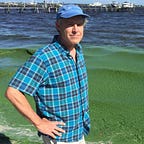Brevard Voters May Be Smarter
The Indian River Lagoon is one of America’s most beautiful and complicated waterways. Like other Floridians, I used to take the 156-mile waterway for granted. The estuary had remarkable birdlife, outstanding fishing, herds of manatees, beautiful marshes, and remarkable viewscapes from the barrier islands to the west and from the mainland to the east.
Brevard County straddles much of the Indian River Lagoon. The fast-growing area just east of Orlando’s theme parks is known for its long stretches of sandy beaches, the Kennedy Space Center, and famed Indian River citrus.
It is such a nice place that over the years millions of people moved in and hundreds of thousands of houses were built. Many of those homes have septic tanks that send wastewater into the lagoon. Poor stormwater management and wetland destruction compound the problem of an estuary alternately overloaded and deprived of seasonal freshwater.
Also, homeowners cultivate green lawns on sandy soils by adding fertilizer that quickly washes into the lagoon.
In 2016, the lagoon’s capacity to assimilate so much pollution was overwhelmed. A “fish-apocalypse” left millions of dead and rotting fish floating in the water and littering the shore.
In response to public outcry, the Brevard County Commission placed a one-half-cent sales tax dedicated to lagoon cleanup on the November 8, 2016, ballot. The Save Our Indian River Lagoon sales tax passed with more than 60% of the vote and now generates about $50 million per year.
The massive fish kills motivated the conservative county’s voters to support the tax. However, assurances that the funds would be guided by an appointed citizen committee rather than elected officials helped offset voter skepticism about county government.
The Marine Resources Council, a well-regarded Indian River Lagoon science and education organization, supported the referendum and has tracked the program’s progress. The group’s executive director Leesa Souto told me, “People are more likely to tax themselves if they feel reassured that the money will be used for its intended purpose.”
Souto also said that people want to see results. In the years since the Save Our Indian River Lagoon was approved, spending lagged but is now catching up with revenue. Now more than $50 million dollars have been committed to projects to remove pollutants from water going into the lagoon.
One concern mentioned by several lagoon advocates was the decision to reprioritize spending. Initially, funds were going to stormwater treatment, replacing septic with sewers, and muck removal. At some point local wastewater utilities made a pitch for upgrading treatment plants and money was diverted from muck removal.
Duane De Freese, executive director of the Indian River Lagoon National Estuary Program, pointed out that the current level of spending does not meet the projected cost of all the projects.
Brevard County is considering a second referendum. This time a penny may be on the ballot and may generate $100 million per year. That vote could demonstrate to state legislators and to Congress that cleaning up coastal waters is so popular, people are willing to vote to pay more.
I hope to follow the plan and share more insights. The plan can be found at:
https://www.brevardfl.gov/SaveOurLagoon/ProjectPlan
According to a survey conducted on behalf of the Brevard Indian River Lagoon Coalition, most people are prepared to pay higher fees to pay for projects to clean up Florida waterways. 62.4% say they agree or strongly agree with paying an extra $2 a month. Smart voters!
For more information check out:
Marine Resources Council at https://savetheirl.org/
Indian River Lagoon NEP https://onelagoon.org/
Brevard Indian River Lagoon Coalition https://www.facebook.com/BIRLC/
